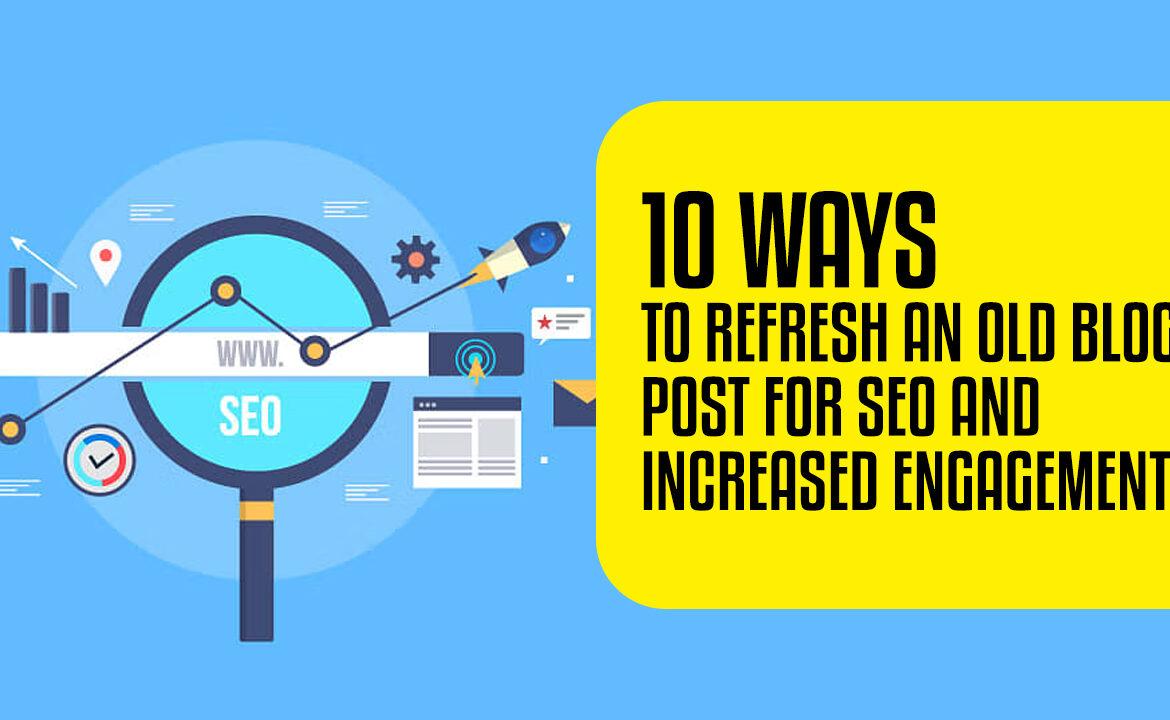10 Ways to Update Old Blog Posts for SEO and Increased Engagement
When you have a blog post that is a few years old, it can be difficult to know how to update it without damaging its search engine optimization (SEO) and overall engagement. In this blog post, we will give you 10 different ways to update old blog posts! By following these tips, you can keep your website fresh and updated while also improving your search engine optimization ranking. Let’s get started!

If you’ve been publishing material to your blog for a while, you’ll probably have outdated articles that are no longer relevant, don’t link to recent posts, aren’t in sync with your current content standards, or aren’t up to scratch… the list goes on.
On the other hand, those old blog entries are most likely falling in search rankings, resulting in less traffic to your site and fewer conversions for whatever you’re selling.
You can update and modernise the information in your outdated content by learning how to refresh old blog articles, and then using that knowledge to update and improve it.
If you’re looking for a platform that can help you update your old blog posts for better SEO and increased engagement, look no further than jasper.ai. Our platform makes it easy to refresh your content, optimize your meta information, and add new visuals in order to revive old blog posts and keep them visible to your users and search engines. So why wait? Sign up for jasper.ai today and see how we can help you take your content to the next level!

Also, read How To Use The Jasper AI Text Summarizer, How To Make Money With Jasper? 30 Proven Ways People Are Using Jasper To Make Money, Jasper.Ai Review: AI Content Generator(2021)
Why Is It Necessary to Update Existing Content?
There might be a variety of reasons why you may wish to update old material rather than just continuously creating new stuff. Here are some of my top reasons for doing so.
It’s a Google ranking factor. It is important for Google to know that you are concerned about your old material. Or, rather, it is crucial for Google to provide up to date information to its customers. As far as Google is concerned, freshly updated information is just as good as brand new material. In some situations, it might be even better since it has a track record of providing value. Refreshing outdated content may improve the search engine optimization of your whole site.
If a piece of content has been out there for over a year and is still getting traffic, it could get another boost from the press. You can update a piece of content and add an “Updated X/X/X” dateline, then use your standard promotion engine to distribute it. Send it through your email list, put it on social media, or whatever else you do. A fresh influx of visitors will be able to leave new comments and links and focus on the material.
People are more willing to believe in fresh content. Even if the information hasn’t changed, it’s still relevant to keep it up to date because people will naturally flock to the most recent version of a piece of knowledge. They simply want confirmation that it continues to function or is still valid, even if it hasn’t been updated in years.

It saves you a lot of time. How much work is it to produce a new blog post? Of course, you do. You may gain the benefit of “fresh” material to fill a space on your editorial calendar by updating and “republishing” an old post without having to create completely new material.
Also, read Common Content Writing Problems And How We Solve Problems In Writing Content For Our Clients Using A Simple AI Tool, How To Write A Blog Post In 20 Minutes, and How To Create Compelling Social Media Content?
10 Ways to Update Old Blog Posts for SEO
- Locate the keywords that it’s currently ranking for.
The first thing you should do is figure out which keywords your post is currently ranking for. Begin by looking for keywords that are on page one or two of the SERPs, generally positions 1-20 (generally positions 1-20).

- Underperforming sites with content issues can be detected.
Republishing any old post isn’t going to help you enhance organic traffic. You must locate those that are underperforming due to content concerns.
If your post ranks in the top three for its target keyword, it’s probably not a good candidate for republishing because the risk outweighs the gain. It’s already functioning effectively, so republishing may do more harm than good.
For that reason, search for articles that rank lower than their primary keyword.
- Make a new version and link to part 2
When the old post is far gone, a simple technique may be to simply write and publish a new article on the same subject. Simply write and submit that new piece of writing. Then go back to the old post and place an enormous warning at the top of it, such as: “This material is outdated! For fresh, up-to-date information, click here!”
- Look for any other keywords you want to target.
A single blog article may be the basis for multiple featured snippets. As a result, I prefer to look for not only my target keyword but also any of my secondary keywords. If one of my additional keywords has its own distinct highlighted snippet, I take note of it and add it to my content strategy.
- Update the on-page SEO.
On an old blog post, updating and implementing your search engine optimization strategy occurs in a few key areas. You’ll have to update and optimize the following aspects of your site:
- SEO Title Tag
- Meta Description
- Article Title
- Subheadings
- Add fresh content to existing comment topics
Once your blog is old enough to be concerned with refreshing and recovering old content, you probably also have a bit of a community going, and comments on your blog posts. A lot of those comments are going to be boring or valueless, the usual “thanks for writing this!” kinds of comments. Some, though, might ask valid questions or bring up tertiary topics you didn’t cover.
- Extend the post’s scope to include third-tier themes.
You may do the same thing with tertiary subjects without using comments to guide you in the same way.
What we love doing is looking at any new material that has been published on those secondary subjects since the original topic was published. Find and write short pieces on topics relevant to your primary theme. Then provide an “if this interests you, we wrote more about it here” connection to the new posts.
- Update the meta-information
Refreshing your meta information is a fantastic approach to get Google to give your material a second look. If your post’s metadata was created before Google expanded the character limit, it may have been from years ago. You’ll have more room to further describe your articles.
- Optimize and add new photos or videos.
High-quality blogs have high-quality visuals. Bringing images and videos back to a dormant blog post allows us to provide a better user experience while also increasing search engine optimization possibilities.
- Change the layout or format.
Make your document conform to search engine optimization best practices. As previously said, the world of internet marketing is a dynamic one, changing rapidly. The ideal format changes for current search engine optimization recommendations include defining your target keyword, including numbered lists near the top of the post, and utilizing headers and subheadings to lend structure to your keyword.
The world of online marketing is a fast-paced one. Its best practices are always in flux. To stay on top of current search engine optimization techniques and provide a high-quality user experience, you must update your content on a regular basis. This article will show you how to bring new life to your blog posts and keep them visible to your users and search engines with the help of this advice.
Also, read How to Develop Strong Content Marketing Plan for Small Businesses, How AI Tools For Content Writing Can Help You Generate Safe and Engaging Content, How to Write Profitable Content for Your Website


1 thought on “10 Ways to Update Old Blog Posts for SEO and Increased Engagement”